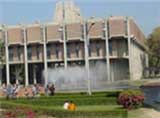Should the IITian be Dilberted?
By Uday Chatterjee | 22 Sep 2003
Mumbai: In recent times, professional education and the Indian Institutes of Technology (IITs) in particular hogged the limelight. Scott Adams, creator of the world famous comic strip Dilbert, profiled the IIT graduate in two consecutive comic strips last week. One of the strips portrayed the IITian as a guy who "re-heats his coffee by holding the coffee mug to his forehead and imagining fire."

Cartoon or lampoon, Adams has covertly acknowledged that the IITian and the Indian techie are extraordinarily talented and that talent is now being recognised globally.
The reason why an IIT graduate is talented is simple. He manages to crack what could arguably be described as one of the toughest entrance test in the world. To know how tough the IIT entrance test is, here is a sample of a possible IIT entrance test question and the solution:
Question: How much milk is two litres milk plus four litres milk?
Solution: Say, X = 2
Then 2 x X = 2 x 2 = 4
Further, 2 x X x 0 = 2 x 2 x 0 = 0 ………(A)
Say, Y = 4
Then 2 x Y = 2 x 4 =8
Further, 2 x Y x 0 = 2 x 4 x 0 = 0………(B)
We now have, A = B
That is, 2 x Y x 0 = 2 x X x 0
Cancelling the equal numbers from both sides, we have Y = X
That is, 2 = 4.
Hence, two litres milk plus four litres milk is equal to four litres milk or eight litres milk.
 IITs were conceived way back in 1946 when a committee was set up by Sir Jogendra Singh, a member of the viceroy's executive council, department of education, health and agriculture, to consider the setting up of higher technical institutions for postwar industrial development in India.
IITs were conceived way back in 1946 when a committee was set up by Sir Jogendra Singh, a member of the viceroy's executive council, department of education, health and agriculture, to consider the setting up of higher technical institutions for postwar industrial development in India.
The committee in its report recommended the establishment of four higher technical institutions in the eastern, western, northern and southern regions, possibly on the lines of the Massachusetts Institute of Technology, USA, with a number of secondary institutions affiliated to it.
With the recommendations of the committee in view, the first IIT was born in May 1950 in Kharagpur in the eastern part of India. Over the years, six more IITs were established.
By Acts of the Indian parliament, these institutions were given the status as institutions of national importance and this importance was highlighted by Jawaharlal Nehru who in the first convocation address at Kharagpur in 1956 said: "Here stands the fine monument of India, representing India's urges, India's future in the making. This picture seems to me symbolical of the changes that are coming to India."
 Has that happened? Yes, and much more. It is not just India but across the world that Indian skills are being recognised. The IITs have become a global brand. There is now a demand from developing nations like Sri Lanka, Singapore, Mauritius and West Asian and South East Asian countries for setting up IIT campuses in their countries.
Has that happened? Yes, and much more. It is not just India but across the world that Indian skills are being recognised. The IITs have become a global brand. There is now a demand from developing nations like Sri Lanka, Singapore, Mauritius and West Asian and South East Asian countries for setting up IIT campuses in their countries.
With all that, there appears to be a groundswell of resentment against the IITian and the Indian techies in the US and other developed countries. Part of the resentment against the techies is understandable as the techies in the developed countries are losing out on jobs. But isn't it all about globalisation, competition and technical excellence?
Bill Gates and the IBMs prefer to hire Indian techies not because they love them more than their country cousins but because they know that it is only with the services of these techies that they can stay in competition and thrive. And no legislation, be it in the state of New Jersey or California, can stop this trend.
There is also resentment in India about the IITian going abroad after his education which is almost fully subsidised by the Indian government. Rahul Bajaj of Bajaj Auto, who was recently appointed chairman of the board of governors of IIT Bombay came down heavily against the subsidies which in the ultimate analysis is paid for by the Indian poor.
 Why does the IITian go abroad? A chemical engineer from the 1974 batch joined the prestigious Shaw Wallace and Company after graduation. In a year's time he mastered the art of sleeping on the job with his eyes wide open. When asked, he said the only thing he had to do there was that every third Wednesday, the foreman would come up to him with a flustered look and say: "Saab, jacketed vessel ka nalli mein leak hai."
Why does the IITian go abroad? A chemical engineer from the 1974 batch joined the prestigious Shaw Wallace and Company after graduation. In a year's time he mastered the art of sleeping on the job with his eyes wide open. When asked, he said the only thing he had to do there was that every third Wednesday, the foreman would come up to him with a flustered look and say: "Saab, jacketed vessel ka nalli mein leak hai."
He would then take an officious look at the nalli and proclaim: "Store se naya nalli lao." Next Saturday, he would report the matter to the top management. All this after spending five rigorous years trying to master subjects like thermodynamics and stoichiometry.
Should the IITian be subsidised? N R Narayanamurthy of Infosys had cracked the IIT entrance exam and although he was offered a scholarship (a measly amount; doled out at the end of the year), he could not afford to complete his graduation at IIT.
He later did his post-graduation at IIT Kanpur only because the scholarship amount was affordable. Will Bajaj please tell us the number of Narayanamurthys lost — and to be lost — to the country and the globe if the IITs are not subsidised? And aren't the IITians nowadays paying back their alma mater?
No Mr Bajaj, it's better that the IITian go and earn name and fame abroad rather than be Dilberted at Bajaj Auto.






























